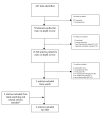Does the routine use of global coronary heart disease risk scores translate into clinical benefits or harms? A systematic review of the literature
- PMID: 18366711
- PMCID: PMC2294118
- DOI: 10.1186/1472-6963-8-60
Does the routine use of global coronary heart disease risk scores translate into clinical benefits or harms? A systematic review of the literature
Abstract
Background: Guidelines now recommend routine assessment of global coronary heart disease (CHD) risk scores. We performed a systematic review to assess whether global CHD risk scores result in clinical benefits or harms.
Methods: We searched MEDLINE (1966 through June 13, 2007) for articles relevant to our review. Using predefined inclusion and exclusion criteria, we included studies of any design that provided physicians with global risk scores or allowed them to calculate scores themselves, and then measured clinical benefits and/or harms. Two reviewers reviewed potentially relevant studies for inclusion and resolved disagreement by consensus. Data from each article was then abstracted into an evidence table by one reviewer and the quality of evidence was assessed independently by two reviewers.
Results: 11 studies met criteria for inclusion in our review. Six studies addressed clinical benefits and 5 addressed clinical harms. Six studies were rated as "fair" quality and the others were deemed "methodologically limited". Two fair quality studies showed that physician knowledge of global CHD risk is associated with increased prescription of cardiovascular drugs in high risk (but not all) patients. Two additional fair quality studies showed no effect on their primary outcomes, but one was underpowered and the other focused on prescribing of lifestyle changes, rather than drugs whose prescribing might be expected to be targeted by risk level. One of these aforementioned studies showed improved blood pressure in high-risk patients, but no improvement in the proportion of patients at high risk, perhaps due to the high proportion of participants with baseline risks significantly exceeding the risk threshold. Two fair quality studies found no evidence of harm from patient knowledge of global risk scores when they were accompanied by counseling, and optional or scheduled follow-up. Other studies were too methodologically limited to draw conclusions.
Conclusion: Our review provides preliminary evidence that physicians' knowledge of global CHD risk scores may translate into modestly increased prescribing of cardiovascular drugs and modest short-term reductions in CHD risk factors without clinical harm. Whether these results are replicable, and translate across other practice settings or into improved long-term CHD outcomes remains to be seen.
Figures


References
-
- Frolkis JP, Zyzanski SJ, Schwartz JM, Suhan PS. Physician noncompliance with the 1993 National Cholesterol Education Program (NCEP-ATPII) guidelines. Circulation. 1998;98:851–855. - PubMed
-
- Pearson TA, Laurora I, Chu H, Kafonek S. The lipid treatment assessment project (L-TAP): a multicenter survey to evaluate the percentages of dyslipidemic patients receiving lipid-lowering therapy and achieving low-density lipoprotein cholesterol goals. Arch Intern Med. 2000;160:459–467. doi: 10.1001/archinte.160.4.459. - DOI - PubMed
Publication types
MeSH terms
Grants and funding
LinkOut - more resources
Full Text Sources
Miscellaneous

